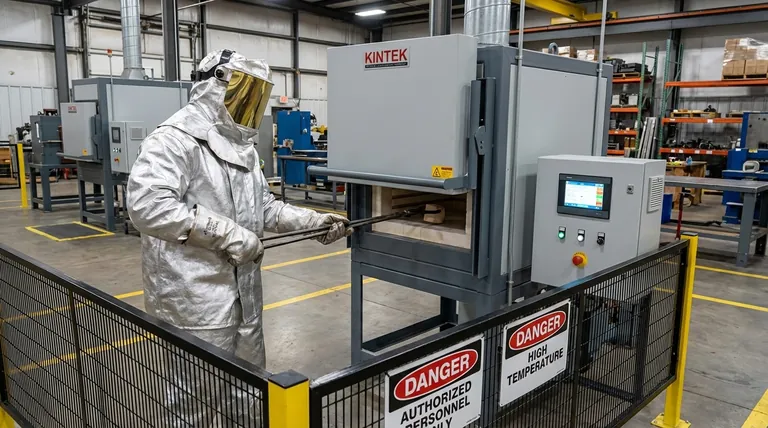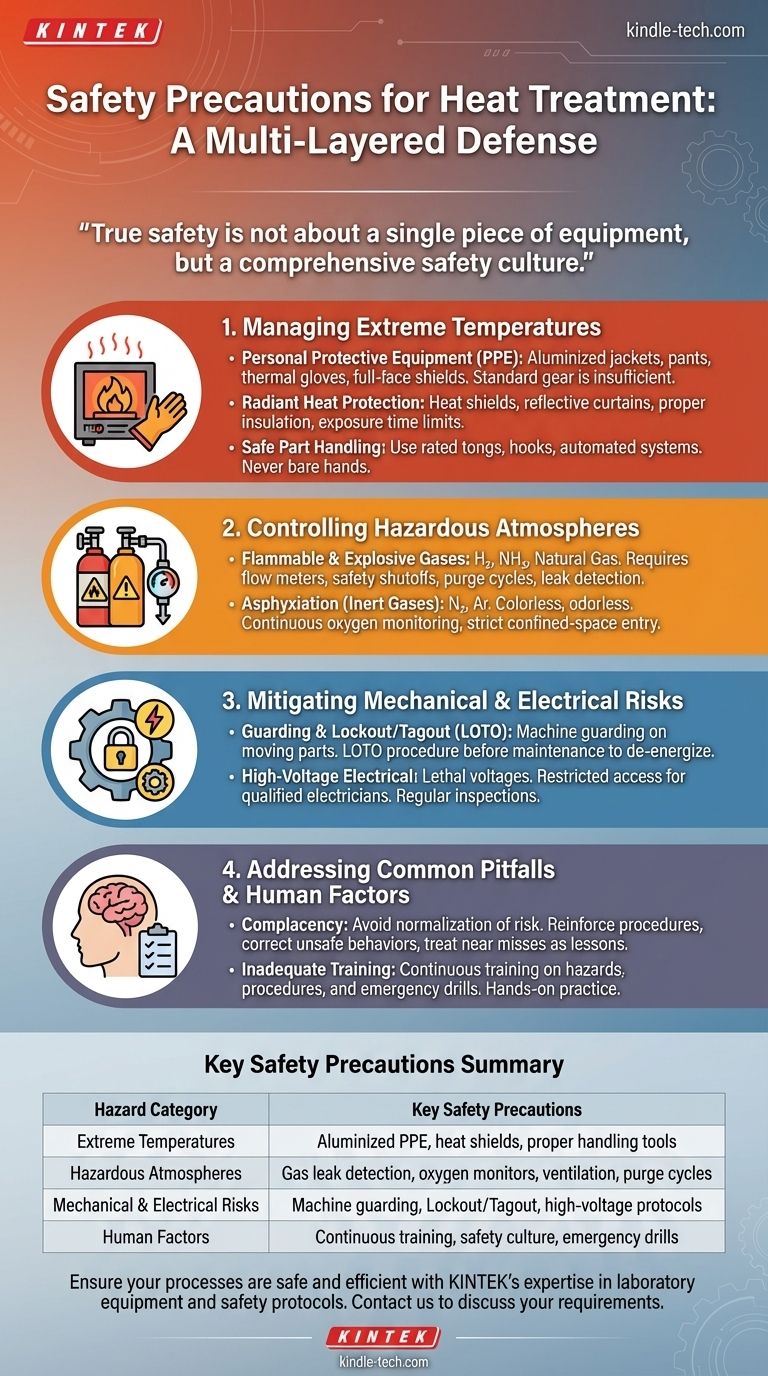In short, the essential safety precautions for heat treatment involve a multi-layered system of personal protective equipment (PPE), engineered equipment controls, and rigorous operational procedures. This system is designed to manage the primary hazards of extreme temperatures, hazardous atmospheres, and powerful machinery.
The most critical takeaway is that true safety in heat treatment is not about a single piece of equipment or a rule, but about establishing a comprehensive safety culture. This culture must address all potential hazards—from thermal and chemical to mechanical—through continuous training, procedural discipline, and engineering controls.

Managing the Primary Hazard: Extreme Temperatures
Heat treatment, by definition, involves temperatures that can cause severe injury or fatality almost instantly. Managing this primary risk requires both personal gear and environmental controls.
Personal Protective Equipment (PPE)
Your first line of defense is specialized PPE designed for high-heat environments. Standard work gloves or glasses are entirely insufficient.
The minimum requirement includes aluminized or heat-resistant jackets and pants, thermal gloves or mitts, and a full-face shield over safety glasses. For work near open furnaces, a full hood or proximity suit may be necessary.
Protection from Radiant Heat
Direct contact is not the only danger. Radiant heat can cause serious burns and heat stress from a distance.
Engineered solutions like heat shields, reflective curtains, and proper insulation on equipment are critical. Administrative controls, such as limiting exposure time in high-heat zones, are also essential.
Safe Part Handling
Never handle parts, fixtures, or tooling with bare hands, even if they appear cool. Heat-treated components can retain dangerous temperatures for long periods.
Always use properly rated tongs, hooks, or automated systems for loading, unloading, and moving materials. Ensure these tools are in good condition and stored away from walkways.
Controlling Hazardous Atmospheres
Many heat treatment processes occur in controlled atmospheres to achieve specific metallurgical properties. These atmospheres introduce significant chemical, fire, and explosion risks.
Flammable and Explosive Gases
Furnaces using gases like hydrogen, ammonia, or natural gas present a constant explosion risk if not managed precisely.
Systems must have reliable flow meters, safety shutoff valves, and purge cycles to ensure explosive mixtures cannot form. Meticulous leak detection and ventilation are non-negotiable.
Asphyxiation from Inert Gases
Inert gases like nitrogen and argon, while not flammable, are a leading cause of fatalities due to asphyxiation. They are colorless and odorless and displace oxygen in enclosed spaces.
Any area where these gases are used must have continuous oxygen monitoring alarms. Never permit personnel to enter a furnace chamber or confined space without following strict confined-space entry protocols.
Mitigating Mechanical and Electrical Risks
Heat treatment facilities are industrial environments with heavy machinery and high-power systems that demand respect and strict safety protocols.
Guarding and Lockout/Tagout
Furnaces often have automated doors, conveyors, and transfer mechanisms. All moving parts must be fully guarded to prevent crush and pinch-point injuries.
Before any maintenance, a formal Lockout/Tagout (LOTO) procedure must be followed to de-energize all power sources—electrical, pneumatic, and hydraulic—preventing accidental startup.
High-Voltage Electrical Hazards
The power systems for induction and resistance furnaces operate at lethal voltages and amperages. Access to electrical cabinets must be strictly limited to qualified and authorized electricians.
Regular inspection of wiring, contacts, and insulation is a critical preventive maintenance task to prevent arc flash and electrocution.
Common Pitfalls: Overlooking the Invisible Dangers
The most severe accidents often happen not because of a single catastrophic failure, but from a slow erosion of standards and a failure to recognize less obvious risks.
Complacency and Normalization of Risk
The single greatest threat in any industrial setting is complacency. When a team works around extreme hazards daily, it's easy to start taking shortcuts or ignoring minor issues.
Leaders must actively combat this by reinforcing procedures, correcting unsafe behaviors immediately, and celebrating a proactive safety mindset. Never treat a "near miss" as a success; treat it as a free lesson on a system vulnerability that must be fixed.
Inadequate Training
Simply providing PPE is not enough. Personnel must be thoroughly trained on what the hazards are, why procedures exist, and what to do in an emergency.
This includes hands-on drills for fires, gas leaks, and medical emergencies. Training is not a one-time event but a continuous process.
Making the Right Choice for Your Goal
Your safety focus will change slightly depending on your role within the operation. Use these points to guide your actions.
- If your primary focus is day-to-day operation: Always conduct a pre-use inspection of your PPE and equipment, and never deviate from established safety procedures.
- If your primary focus is managing the facility: Implement a robust preventive maintenance schedule for all safety systems and conduct regular, documented safety audits and training drills.
- If your primary focus is engineering a new process: Design safety in from the start by specifying automated handling, comprehensive atmospheric controls, and foolproof guarding wherever possible.
Ultimately, a safe heat treatment operation is one where every person, from the floor operator to the plant manager, is empowered and responsible for maintaining a vigilant watch over the process.
Summary Table:
| Hazard Category | Key Safety Precautions |
|---|---|
| Extreme Temperatures | Aluminized PPE, heat shields, proper handling tools (tongs, hooks) |
| Hazardous Atmospheres | Gas leak detection, oxygen monitors, ventilation, purge cycles |
| Mechanical & Electrical Risks | Machine guarding, Lockout/Tagout (LOTO), high-voltage safety protocols |
| Human Factors | Continuous training, safety culture, emergency drills, risk awareness |
Ensure your heat treatment processes are safe and efficient with KINTEK's expertise.
We specialize in providing laboratory equipment and consumables tailored to your needs, including heat treatment furnaces with built-in safety features. Our team can help you select the right equipment and establish robust safety protocols to protect your personnel and operations.
Contact us today to discuss your specific requirements and learn how KINTEK can support your laboratory's safety and performance goals.
Visual Guide

Related Products
- Laboratory Muffle Oven Furnace Bottom Lifting Muffle Furnace
- 1800℃ Muffle Oven Furnace for Laboratory
- 1400℃ Muffle Oven Furnace for Laboratory
- 1700℃ Muffle Oven Furnace for Laboratory
- 1400℃ Laboratory Quartz Tube Furnace with Alumina Tube Tubular Furnace
People Also Ask
- What is the temperature limit on a muffle furnace? A Guide to Selecting the Right Model
- What is the burnout cycle on a furnace? Stop This Destructive Overheating Pattern Now
- What are the factors affecting the rate of melting process? Master Heat Transfer for Faster Results
- What affects the melting point of a substance? Uncover the Key Factors & Forces
- Do different liquids melt at different rates? Unlock the Science of Melting Points and Material Properties



















